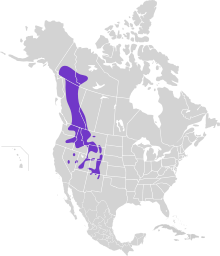| Dusky grouse | |
|---|---|

| |
| Male displaying, Yellowstone National Park | |

| |
| Female in New Mexico, USA | |
| Conservation status | |
 Least Concern (IUCN 3.1) | |
| Scientific classification | |
| Domain: | Eukaryota |
| Kingdom: | Animalia |
| Phylum: | Chordata |
| Class: | Aves |
| Order: | Galliformes |
| Family: | Phasianidae |
| Genus: | Dendragapus |
| Species: | D. obscurus |
| Binomial name | |
| Dendragapus obscurus (Say, 1822) | |

| |
The dusky grouse (Dendragapus obscurus) is a species of forest-dwelling grouse native to the Rocky Mountains in North America. It is closely related to the sooty grouse (Dendragapus fuliginosus), and the two were previously considered a single species, the blue grouse.
Description
Adults have a long square tail, gray at the end. Adult males are mainly dark with a purplish throat air sac surrounded by white, and a yellow to red wattle over the eye during display. Adult females are mottled brown with dark brown and white marks on the underparts.
Males are larger than females, with a male mean body mass of 1.21 kg (2.67 lbs.) compared to a mean 0.91 kg (2.01 lbs.) in females.
Distribution and habitat
The breeding habitat of the dusky grouse is the edges of conifer and mixed forests in mountainous regions of western North America, from southeastern Alaska and Yukon south to New Mexico. Their range is closely associated with that of various conifers. Their nest is a scrape on the ground concealed under a shrub or log.
Taxonomy
The dusky grouse has four recognized subspecies:
- D. o. obscurus (Say, 1822)
- D. o. oreinus (Behle & Selander, 1951)
- D. o. pallidus (Swarth, 1931)
- D. o. richardsonii (Douglas, 1829)
Migration
They are permanent residents but move short distances by foot and short flights to denser forest areas in winter, with the odd habit of moving to higher altitudes in winter.
Diet
Dusky grouse forage mainly for plant matter on the ground, as well as in trees and along branches (in the winter). During the coldest months, they mainly eat fir and douglas-fir needles, occasionally consuming hemlock and pine needles, as well. Then, in the spring and summer, the fresh green growth of various herbaceous perennials (Pteridium, Salix) and berry plants (Gaultheria, Mahonia, Rubus, Vaccinium), as well as invertebrates (particularly larger ants, beetles, crickets and grasshoppers), become more available and thus more readily consumed. Chicks are almost entirely dependent on insect prey for several weeks after hatching.
Breeding
Males sing with deep hoots on their territory and make short flapping flights to attract females. Females leave the male's territory after mating.
References
- BirdLife International (2016). "Dendragapus obscurus". IUCN Red List of Threatened Species. 2016: e.T22734690A95095102. doi:10.2305/IUCN.UK.2016-3.RLTS.T22734690A95095102.en. Retrieved 12 November 2021.
- ^ del Hoyo, J., Elliott, A., & Sargatal, J., eds. (1994). Handbook of the Birds of the World 2: 401–402. Lynx Edicions, Barcelona ISBN 84-87334-15-6.
- ^ Sibley, D. (2000). The Sibley Guide to Birds. Knopf. p. 143. ISBN 0-679-45122-6.
- Banks, R. C.; Cicero, C.; Dunn, J. L.; Kratter, A. W.; Rasmussen, P. C.; Remsen, J. V. Jr.; Rising, J. D.; Stotz, D. F. (2006). "Forty-seventh Supplement to the American Ornithologists' Union Check-list of North American Birds" (PDF). The Auk. 123 (3): 926–936. doi:10.1642/0004-8038(2006)123[926:FSTTAO]2.0.CO;2. Retrieved 2007-09-16.
- Dunning, Jr., John B. (2008). CRC Handbook of Avian Body Masses (2nd ed.). CRC Press. p. 71. ISBN 978-1-4200-6444-5.
- Gill, Frank; Donsker, David; Rasmussen, Pamela, eds. (July 2021). "Pheasants, partridges, francolins". IOC World Bird List Version 11.2. International Ornithologists' Union. Retrieved 13 October 2021.
External links
| Taxon identifiers | |
|---|---|
| Dendragapus obscurus |
|